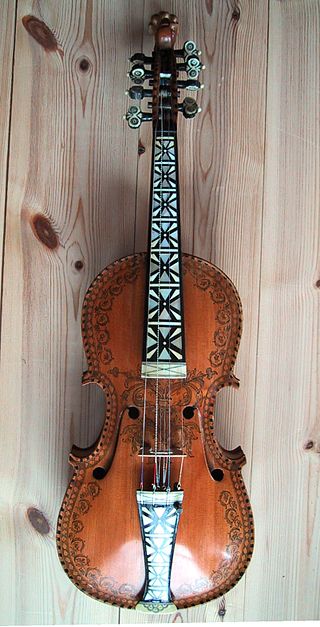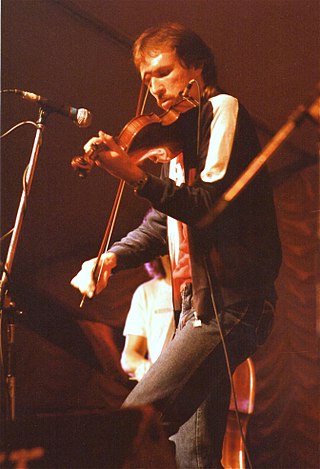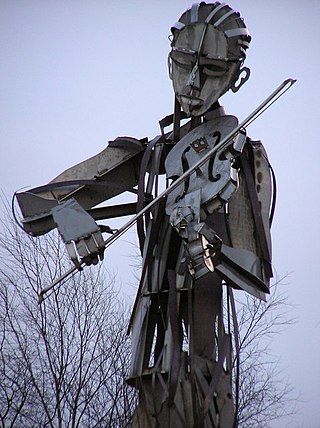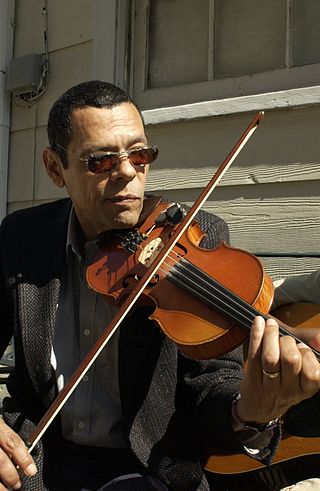
The Donegal fiddle tradition is the way of playing the fiddle that is traditional in County Donegal, Ireland. It is one of the distinct fiddle traditions within Irish traditional music.

A fiddle is a bowed string musical instrument, most often a violin. It is a colloquial term for the violin, used by players in all genres, including classical music. Although in many cases violins and fiddles are essentially synonymous, the style of the music played may determine specific construction differences between fiddles and classical violins. For example, fiddles may optionally be set up with a bridge with a flatter arch to reduce the range of bow-arm motion needed for techniques such as the double shuffle, a form of bariolage involving rapid alternation between pairs of adjacent strings. To produce a "brighter" tone than the deep tones of gut or synthetic core strings, fiddlers often use steel strings. The fiddle is part of many traditional (folk) styles, which are typically aural traditions—taught "by ear" rather than via written music.

Bluegrass music is a genre of American roots music that developed in the 1940s in the Appalachian region of the United States. The genre derives its name from the band Bill Monroe and the Blue Grass Boys. Like mainstream country music, it largely developed out of old-time string music, though in contrast, bluegrass is traditionally played exclusively on acoustic instruments and also has roots in traditional English, Scottish, and Irish ballads and dance tunes as well as in blues and jazz. Bluegrass was further developed by musicians who played with Monroe, including 5-string banjo player Earl Scruggs and guitarist Lester Flatt. Monroe characterized the genre as, "Scottish bagpipes and ole-time fiddlin'. It's a part of Methodist, Holiness and Baptist traditions. It's blues and jazz, and it has a high lonesome sound."

Cajun music, an emblematic music of Louisiana played by the Cajuns, is rooted in the ballads of the French-speaking Acadians of Canada. Although they are two separate genres, Cajun music is often mentioned in tandem with the Creole-based zydeco music. Both are from southwest Louisiana and share French and African origins. These French Louisiana sounds have influenced American popular music for many decades, especially country music, and have influenced pop culture through mass media, such as television commercials.

A Hardanger fiddle is a traditional stringed instrument considered to be the national instrument of Norway. In modern designs, this type of fiddle is very similar to the violin, though with eight or nine strings and thinner wood. The F-holes of the Hardanger fiddle are distinctive, oftentimes with a more "sunken" appearance, and generally straighter edges. Four of the strings are strung and played like a violin, while the rest, named understrings or sympathetic strings, resonate under the influence of the other four. These extra strings are tuned and secured with extra pegs at the top of the scroll, effectively doubling the length of a Hardingfele scroll when compared to a violin. The sympathetic strings, once fastened to their pegs, are funneled through a "hollow" constructed fingerboard, which is built differently than a violin's, being slightly higher and thicker to allow for these extra strings. The resonant strings lie on the center of the special bridge, attached to extra hooks on the tailpiece. Carved out within the center of the bridge is a smaller secondary "bridge", or opening, designed specifically for these resonant strings to pass through. This is where the resonance is picked up and reverberated; as notes are played, the vibrations are sent through the bridge, where the sympathetics echo those notes.

Old-time music is a genre of North American folk music. It developed along with various North American folk dances, such as square dancing, clogging, and buck dancing. It is played on acoustic instruments, generally centering on a combination of fiddle and plucked string instruments, most often the banjo, guitar, and mandolin. The genre is considered a precursor to modern country music.

Mark O'Connor is an American fiddle player and composer whose music combines bluegrass, country, jazz and classical. A three-time Grammy Award winner, he has won six Country Music Association Musician Of The Year awards and, was a member of three influential musical ensembles; the David Grisman Quintet, The Dregs, and Strength in Numbers.
Here Northumbria is defined as Northumberland, the northernmost county of England, and County Durham. According to 'World Music: The Rough Guide', "nowhere is the English living tradition more in evidence than the border lands of Northumbria, the one part of England to rival the counties of the west of Ireland for a rich unbroken tradition. The region is particularly noted for its tradition of border ballads, the Northumbrian smallpipes and also a strong fiddle tradition in the region that was already well established in the 1690s. Northumbrian music is characterised by considerable influence from other regions, particularly southern Scotland and other parts of the north of England, as well as Irish immigrants.

Appalachian music is the music of the region of Appalachia in the Eastern United States. Traditional Appalachian music is derived from various influences, including the ballads, hymns and fiddle music of the British Isles, the African music and blues of early African Americans, and to a lesser extent the music of Continental Europe.

The fiddle is one of the most important instruments in the traditional repertoire of Irish traditional music. The fiddle itself is identical to the violin, however it is played differently in widely varying regional styles. In the era of sound recording some regional styles have been transmitted more widely while others have become more uncommon.

Michael Louis Doucet is an American singer-songwriter and musician best known as the founder of the Cajun band BeauSoleil.
Scottish fiddling may be distinguished from other folk fiddling styles by its particular precision of execution and energy in the delivery, for example, the rendering of the dotted-quaver/semi-quaver rhythmic patterns, commonly used in the Strathspey. Christine Martin, in her Traditional Scottish Fiddling players guide, discusses the techniques of "hack bowing", "the Scotch snap", and "snap bowing". These techniques contrast quite sharply with the most common bowing patterns of Irish fiddling. The style has a very large repertoire consisting of a great variation of rhythms and key signatures. There is also a strong link to the playing of traditional Scottish bagpipes which is better known throughout the world.

Kevin Burke is an Irish master fiddler considered one of the finest living Irish fiddlers. For nearly five decades he has been at the forefront of Irish traditional music and Celtic music, performing and recording with the groups The Bothy Band, Patrick Street, and the Celtic Fiddle Festival. He is a 2002 recipient of a National Heritage Fellowship from the National Endowment for the Arts.

Irish traditional music is a genre of folk music that developed in Ireland.

D'Jalma Garnier is a musician and composer best known for Creole and Cajun fiddle and "outside" musical compositions and collaborations with other artists.

American fiddle-playing began with the early settlers who found that the small viol family instruments were portable and rugged. According to Ron Yule, "John Utie, a 1620 immigrant, settled in the North and is credited as being the first known fiddler on American soil". Early influences were Irish fiddle styles as well as Scottish and the more refined traditions of classical violin playing. Popular tunes included "Soldier's Joy", for which Robert Burns had written lyrics, and other such tunes as "Flowers of Edinburgh" and "Tamlin," which were claimed by both Scottish and Irish lineages.

Old time fiddle is a genre of American folk music. "Old time fiddle tunes" derived from European folk dance tunes such as Jig, Reel, Breakdown, Schottische, Waltz, Two Step and Polka. The fiddle may be accompanied by banjo or other instruments but are nevertheless called "fiddle tunes". The genre traces from the colonization of North America by immigrants from England, France, Germany, Ireland, and Scotland. It is separate and distinct from traditions which it has influenced or which may in part have evolved from it, such as bluegrass, country blues, variants of western swing and country rock.
Métis fiddle is the style that the Métis of Canada and Métis in the northern United States have developed to play the violin, solo and in folk ensembles. It is marked by the percussive use of the bow and percussive accompaniment. The Metis people are a poly-ethnic post-contact Indigenous peoples. Fiddles were "introduced in this area by Scottish and French-Canadian fur traders in the early 1800s", where the Metis community adopted the instrument into their culture.

Bluegrass mandolin is a style of mandolin playing most commonly heard in bluegrass bands.

















